WASHINGTON PARK HISTORIC WALKING TOUR
Unlike many of the larger cities located on the south shore of Lake Erie, Sandusky still retains a large number of historically significant 19th century residences and commercial buildings. Prior to taking one of the Erie County Historical Society’s Sandusky History walks, it is worth considering some of the events in the city’s history that shaped the city as it has evolved over the past two centuries.
The fact that Sandusky was founded on the Firelands of the Connecticut Western Reserve by residents of Connecticut influenced the city’s future character from its inception. Of the original 13 colonies, Connecticut was one of only two colonies that retained portions of their western lands following the Revolutionary War and the establishment of the United States. Connecticut retained a section of land extending 120 miles west from Pennsylvania between the 41 and 42.2 degrees north latitude that was known as the Connecticut Western Reserve. The western 500,000 acres of the Western Reserve was awarded to those citizens whose homes had been burned by the British during the American Revolution and was referred to as the Firelands. The portion of the Western Reserve west of the Cuyahoga including modern day Erie County and the future site of the City of Sandusky only became available for settlement in 1805 when the land on the Western Reserve west of the Cuyahoga River was purchased in a treaty negotiated with various Native American tribes. Settlers began arriving in the area after it was surveyed in 1809, but the outbreak of the War of 1812 impeded settlement until the conflict in the Northwest ended in the fall of 1813. The contrast between the Ohio towns established on the Western Reserve with those in the rest of the state is striking. A visitor viewing the architecture and public squares in many area towns might assume that he or she was somewhere in New England. Continue Reading...
Isaac Mills and Zalmon Wildman of Connecticut who had conflicting claims to the land in what was to become the City of Sandusky met Colonel James Kilbourne, the founder of Worthington, in 1817 in New York City. He urged the founding of a city on Sandusky Bay that would serve as the link the Great Lakes and the Ohio River Valley via Worthington. A compromise was effected with Wildman receiving 3/4ths and Mills 1/4th of the proposed town which Kilbourne suggested be named the City of Sandusky. Kilbourne was to receive a one quarter share of the town and was the driving force in the city’s early development.
The future town was surveyed and platted in 1818 by Hector Kilbourne, a Freemason and the founder to the Masonic Lodge in Sandusky who imposed the square and compass of the Masonic Emblem on the rectangular grid of the town which continues to confuse travelers to this day. Washington Square, located in the heart of the city, was reserved for “market ground” and for the erection of “public buildings for religious, literacy, state, county and city purposes.” Three additional parks were set aside at the points of the Masonic emblem.
The proprietors were exuberant in their touting of the virtues and prospects of the new town. Advertisements stated that the City of Sandusky:
- Is situated on the south shore of Sandusky Bay, about three miles from the entrance thereof; on a site of ground as beautiful as can be found in the United States.
- Sandusky Bay is the best Harbor on the south shore of Lake Erie, and affords a sufficient draught of water for the largest vessels which are navigated on the upper lakes, to approach near the shore, on which this City is located.
- It is surrounded by as fine a country of land as can be found in the United States, much of which, on the south to the Ohio River is well settled, under good improvement, and is accommodated with turnpike and other public roads, now opening in various directions.
- It is situated on the southernmost part of the upper lakes, and about 100 miles north of Columbus, the seat of state government.
- The advantages of this situation, for commercial and other purposed, are already too well known, to require a more particular description.
- It is, however, second to none in Western America, except the city of New Orleans, and in point of health, greatly its superior.
In spite of these advantages, the city faced numerous rivals on the south shore of Lake Erie and was soon eclipsed by other cities for a number of reasons:
- Sandusky sits on a bed of limestone which proved to be both a blessing and a curse. Limestone was a ready source of the building material that lent character to many buildings built in the downtown area in the 19th century, and provided the raw material for a thriving lime industry, but it also was a major obstacle because it made it difficult to deepen the bay to accommodate the ever larger ships that began to ply the Great Lakes in the second half of the 19th This issue was only resolved in the 1930’s when the Pennsylvania Railroad greatly improved the channel to the Lake from the Lower Lake Docks.
- Sandusky’s chief proprietor, Zalmon Wildman, priced lots in Sandusky at prices well above their market value and on onerous terms and failed it make investments in the city that would have sped its progress.
- With the completion of the Erie Canal in 1825 goods could be economically shipped to and from the East Coast for the first time and the State of Ohio began exploring the possibility of constructing a canal that would link Lake Erie and the Ohio River. Construction of a canal via the Sandusky and Miami Rivers was the shortest route, and had such a canal been constructed, Sandusky would have prospered and mushroomed in size, but this was not to be the case. In 1825 the Canal Commissioners voted to construct two canals – one from Cleveland to the Ohio River via the Cuyahoga, Muskingum-Scioto Route and one extending from Cincinnati to Dayton. The citizens of Sandusky were outraged and decided to construct the Mad River Railroad which would link Sandusky with the Ohio River via the terminus of the canal in Dayton. Railroads were to soon make canals obsolete, but the Mad River Railroad was not a financial success.
Although Sandusky evolved slowly, the city prospered and grew steadily and continued to prosper over the course of the 19th Century. Several major rail lines were extended to the city linking it to the East Coast, to the Ohio River and to the ever expanding western frontier. Sandusky became the world’s largest fresh water fishing port, and ice harvested in the winter enabled fish to be shipped as far as the East Coast. The wine industry thrived in the years after the Civil War, breweries were established, and cooperages were built to facilitate the storage and transport of wine and beer. Grain and lumber were mainstays of the port of Sandusky and ship building flourished on the waterfront.
Cholera Epidemics plagued many U.S. Cities in the early 19th Century including Sandusky. The epidemic of 1849 was particularly severe and led to so many fatalities that its victims had to be buried in mass graves in what came to be known as the Cholera Cemetery. This growth of the city was not slowed for long, however. Large numbers of immigrants from Germany soon began arriving in ever larger numbers. German newspapers, churches, and social organizations were founded and German could often be heard spoken on the streets of the town.
From the 1830’s to the 1850’s, Sandusky was one of the major depots on the Underground Railroad. Many slaves escaped to Canada on ships sailing from the port of Sandusky and many residents held abolitionist sentiments. During the Civil War, a prison was constructed on Johnson’s Island in Sandusky Bay to house Confederate prisoners.
In the 20th century, Sandusky was the home of many manufacturing industries including among others: the New Departure Division of General Motors, Lyman Boat Works, The Hinde and Dauch Paper Company, Diamond Fertilizer, Philco Corporation Radio and Television Division, the Industrial Nut Company. The Barr Ruber Products Company, the Sandusky Foundry and Machine Company, The American Crayon Company, Apex and many others.
Beginning in the last quarter of the 20th century and continuing until today, Sandusky has experienced a loss of industries and population, and the city has gradually become ever more dependent on tourism. The Cedar Point Amusement Park, water parks, boating, fishing and yachting have become mainstays of the city’s economy and the downtown is evolving into a major tourist destination with new restaurants, brew pubs, condominiums and boutique hotels and a theater offering a wide variety of programing.
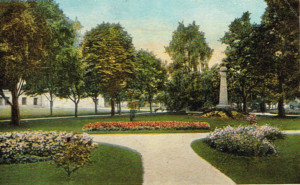
This postcard represents a “scene in Washington Park, Sandusky Ohio.” There is no date, but the stamp area says: Place stamp here ONE CENT for United States and Island Possessions, Cuba, Canada and Mexico. TWO CENTS for foreign.
It is important to recognize the role played by Rice Harper (1803-1891) in the establishment of the Sandusky Park System as it is today. Washington Park was set aside by the original proprietors of the city in 1818 as a “public ground” and a place for “public buildings for religious, literary, state county and city purposes.” Until 1842 the park was an open space with people, wagon teams and animals passing over it in all directions. There was no regular street except Columbus Avenue and a driveway known as Washington Row on the North side.
In 1842 or 1843 the park was enclosed with temporary post and rail fences built with funds obtained by voluntary contributions. They were intended to keep animals off the park and prevent travel through them so that trees and grass could be protected.
In 1855, city council member, Rice Harper, was appointed to chair a committee charged with the permanent improvement of the park. Picket fences were installed and sidewalks were constructed. In 1875 when cattle, horses and hogs were prohibited from running at large in the city, the fences were removed.
In 1879, a Park Commission was established. At the time Washington Street did not extend through Washington Park and the new commission was bent on improving Washington Row. Rice Harper rallied support for extending Washington Street and eventually in 1884 won an Ohio Supreme Court decision which stated that no part of Washington Park included within the lines of Washington Street should be used for any other purpose than a street.
A number of buildings which were built on the park in the 19th century were demolished long ago and today, the Boy with a Boot Fountain, the Popcorn Wagon and numerous floral mounds grace Sandusky’s beautiful Washington Park. The homes of many of Sandusky’s most prominent early citizens were built on Wayne Street which forms the eastern boundary of Washington Park.
START YOUR WALKING TOUR HERE
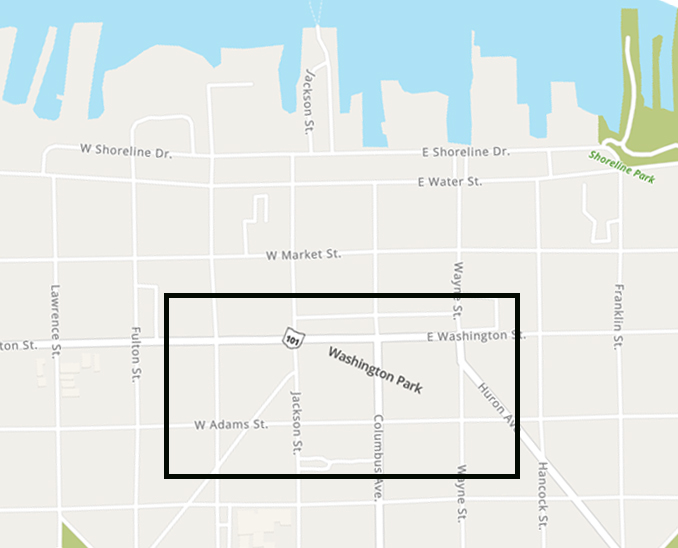
STOP 1 – Start here. Park in the Erie County Parking Garage – SW Corner of Columbus and W. Washington Row. Head South on Columbus Avenue to W. Washington Row.
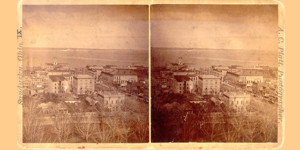
In this stereo image from the 1860s Cooke’s home is the two-story limestone Greek Revival house in the foreground. Image courtesy of Sandusky Library Archives Research Center
FORMER SITE OF THE ELEUTHEROS COOKE HOUSE
NW corner of Columbus Ave. & W. Washington Row
Eleutherous Cooke came to this area in 1818, settling in Bloomingville before moving to Sandusky in 1821. In Sandusky, Cooke became the city’s first lawyer and a well-known politician. During his life Cooke and his family lived in three different homes in downtown Sandusky, the third of which was constructed on this corner in 1843-1844 when Washington Row was primarily a residential area. Cooke lived in this house until his death in 1864.
READ MORE about Cooke, his house and why it still stands, but not on this site!
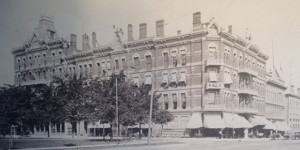
SLOANE HOUSE HOTEL
NW corner of Columbus Ave & W. Washington Row
After relocating the Cooke home, Rush R. Sloane broke ground for a hotel on this corner called the Sloane House, which opened to the public on November 17, 1881. If you were standing here on that day, you would have seen an imposing structure that stretched 299 feet along W. Washington Row and another 92 feet along Columbus Ave.
READ MORE about this first class hotel.
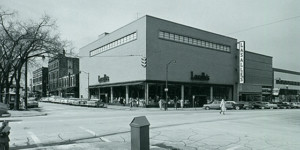
LASALLE’S DEPARTMENT STORE
NW Corner of Columbus Ave. and W. Washington Row
In February of 1948, Toledo-based Lasalle and Koch Company, announced plans to build a department store on this corner, with demolition of part of the Sloane House beginning in September of that year.
READ MORE about this department store.
LaSalle’s, ca. 1955. Image courtesy of Sandusky Library Archives Research Center
STOP 2 – Head North on East Side of Columbus Ave. and Turn Right on E. Washington Row to Jackson St.
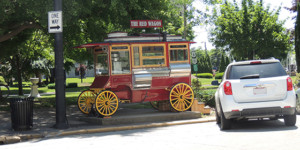
THE RED POPCORN WAGON
NW corner of Columbus Ave. & W. Washington Row
When most people think of popcorn the image of a movie theater lobby comes to mind. The aroma of popcorn and melted butter is engrained in our memories. Yet Washington Park offers a new thought. Finding a permanent home here is the Red Popcorn Wagon of Sandusky. Learn More
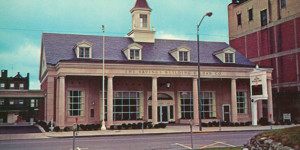
FIRST FEDERAL SAVINGS & LOAN OF LORAIN
207 W. Washington Row
In September 1991, First Federal Savings of Lorain opened this branch and continues to operate it today. Although the corner wing of the Sloane House Hotel was demolished in the late 1940s for construction of the Lasalle’s building, the remaining part of the hotel along West Washington Row was not included in the department store’s development.
Learn More
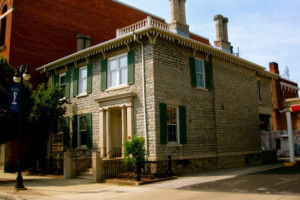
LUCAS BEECHER HOUSE
215 W. Washington Row
Lucas Beecher lived in this stone house. He represented Benjamin Johnson, a fugitive slave who arrived in Sandusky during the 1830’s. Beecher won Johnson’s freedom by arguing that Johnson was not the property of the plaintiff because the purchase was made in Ohio, which was a free state. Johnson then became a free resident of Sandusky. Does the name Harriet Beecher Stowe sound familiar? Learn More
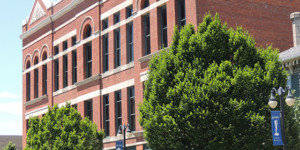
ODD FELLOWS HALL
225 W. Washington Row
The Independent Order of Odd Fellows Hall was constructed in 1889 and dedicated in March of 1890. It sits on property previously owned by Lucas Beecher, whose home still stands just to the east. The architect was John Feick and the builder was George Doezrbach. The architectural style is Victorian Italianate. The beautiful brick building cost $35,000 to erect. Learn More
STOP 3 – Turn Left at Jackson St. Crossing West Washington Row
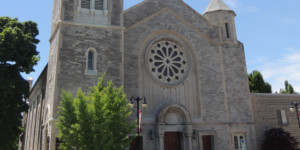
OLD FIRST CHURCH/FIRST PRESBYTERIAN CHURCH
265 Jackson St.
The growth of a church congregation often accompanies an increase in differences among members. Such a division spurned the growth of Old First Church when twenty-six members left the Congregational Church, which evolved into the First Presbyterian Church. By the time construction of the rear chapel commenced in 1853 native limestone had become a widely accepted construction material. Learn More
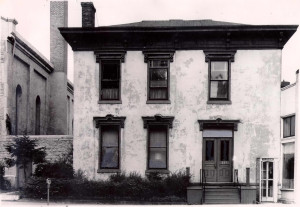
THE SAMUEL CALDWELL HOUSE (demolished 1963)
257 Jackson Street—Stop 3 on Washington Park Walking Tour
In the early 1970s, First Presbyterian Church completed an addition containing educational classrooms north of its main sanctuary building along Jackson St. The location of this addition, however, is notable as the site of the Samuel Caldwell house. READ MORE
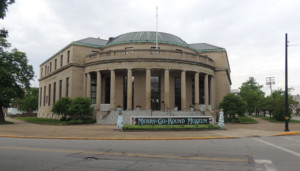
OLD POST OFFICE/MERRY-GO-ROUND MUSEUM
301 Jackson St.
The first post office in Sandusky opened in 1820 in a shanty on Water Street. Succeeding sites included various locations in downtown, most probably in stores, as was the custom.
The Merry-Go-Round Museum displays artifacts that add to the public’s awareness, knowledge, and appreciation of the history of the carousel. Learn More
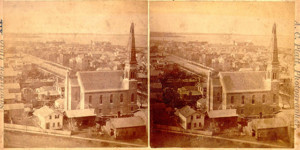
TRINITY METHODIST CHURCH
301 Jackson St.
The Methodist Episcopal Church was organized in the Sandusky area in 1818. The congregation built this church in 1872 on the Southwest corner of Washington Street and Jackson Street.
The church occupied the site until 1918 when the building was raised to make way for the new United State Post Office. Learn More
Trinity Methodist Church, ca 1870s. Image courtesy of Sandusky Library Archives Research Center
STOP 4 – Turn Left and Head East on the Sidewalk Heading Southwest through the park to West Washington Street opposite Boy with a Boot Fountain. Cross Washington Street.
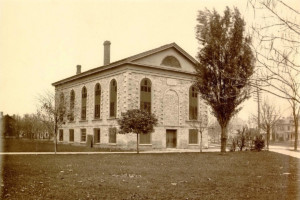
BEATTY CHURCH
SE corner of Washington & Jackson Sts.
A person looking in a south easterly direction from the northeast corner of Jackson and West Washington St. anytime during the latter half of the 19th century would have seen the old Beatty Church which stood just northwest of the courthouse.
Learn More
Beatty Church, ca. 1890. Image courtesy of Sandusky Library Archives Research Center
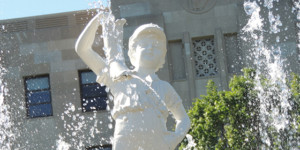
BOY WITH THE BOOT
Washington St, between Columbus Ave. & Jackson St.
The “Boy with the Boot” statue cast by J. W. Fiske Ironworks in New York City made its first appearance in Sandusky in 1895 at the foot of Wayne Street, just about two blocks northeast from here.
Learn More
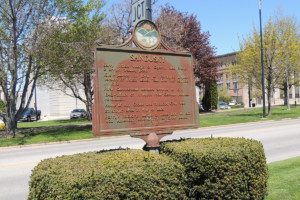
SANDUSKY MARKER
Washington St., between Columbus Ave. & Jackson St.
In 1816, Zalmon Wildman, a citizen of Connecticut, platted “Sandusky City” in Portland Township on the south shore of Sandusky Bay on the site formerly occupied by the Indian chief, Ogontz.
Learn More
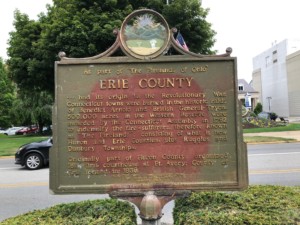
ERIE COUNTY MARKER – WASHINGTON STREET
Between Columbus Ave. & Jackson St.
Erie County had its origin during the Revolutionary War when several towns on the Connecticut Coast were burned by the British. 500,000 acres in the Connecticut Western Reserve in Northern Ohio were awarded by the Connecticut Assembly in 1792 to indemnify the fire-sufferers.
Learn More
STOP 5 – Proceed South from the Boy with a Boot Fountain towards the Court House
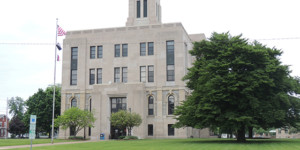
ERIE COUNTY COURTHOUSE – 323 Columbus Ave.
Erie County was established in 1838 from the northern half of Huron County. At that time, and until the courthouse was completed in 1874, the courts met in various locations around town. This first courthouse was in a stone building that was constructed in 1828 as a private academy, to be used as a school and for other educational purposes. the building looks much different today than when it was built. LEARN MORE
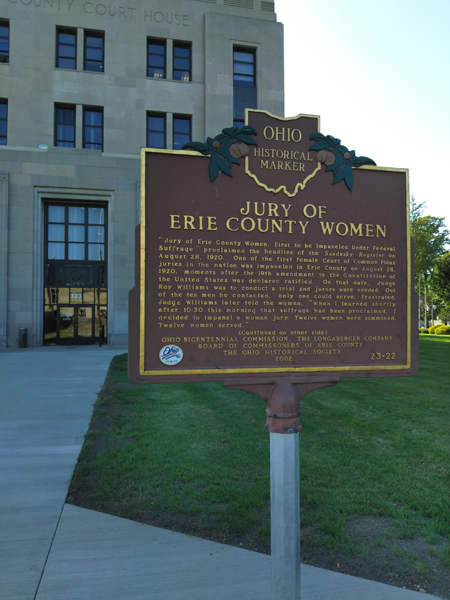 JURY OF ERIE COUNTY WOMEN – HISTORIC MARKER – 323 Columbus Ave.
JURY OF ERIE COUNTY WOMEN – HISTORIC MARKER – 323 Columbus Ave.
One of the first Common Pleas Court juries to be composed of women in the United States was impaneled in Erie County on August 26, 1920, the day Tennessee became the last state necessary to ratify the nineteenth amendment to the United States which provided equal suffrage for women. READ MORE
STOP 6 – Turn Left at Court House Heading East to Columbus Ave. Turn Right and head North on Columbus Ave.
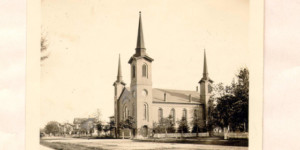
CONGREGATIONAL CHURCH
SW Corner of Columbus Ave. & Washington St.
The Congregational Church was first organized in 1819, but, its first church building was not opened until 1835. The church was built by Henry F. Merry, a carpenter, who came to Sandusky from Milan.
Learn More
Congregational Church, ca. 1860-1870. Image courtesy of Sandusky Library Archives Research Center
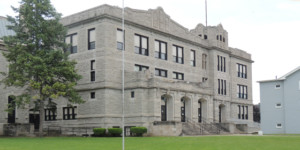
OLD HIGH SCHOOL BUILDING
318 Columbus Ave.
Sandusky was one of the first Ohio towns to establish a public high school. That the high school proved to be an indispensable part of the free school was manifested when the cornerstone for a new building was laid in 1866.
Learn More
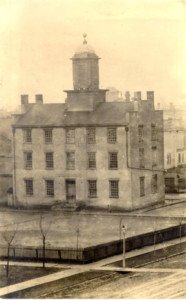
OLD ACADEMY BUILDING (demolished)
Opposite the Court House on the East side of Columbus Ave.
The building was built in 1828 as a school and for other purposes on the East Public Square. The building remained partially unfinished until 1838 when it was appropriated for use as the Court House for the newly created Erie County.
Learn More
Old Academy building, ca. 1870. Image courtesy of Sandusky Library Archives Research Center
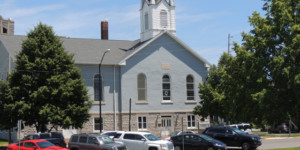
EMMANUEL UNITED CHURCH OF CHRIST
334 Columbus Ave.
Emmanuel Church holds the distinction of being the oldest German-heritage congregation in Sandusky. By the 1840s, a large number of German immigrants had settled in the area and sufficient interest had developed among this group to explore the creation of a church. The official organization of Emmanuel occurred on July 7, 1844 at the Academy Building when twenty-two men met to begin planning for a new church.
Learn More
STOP 7 – Adams St. crosses – Continue south on Columbus Ave. to Jefferson
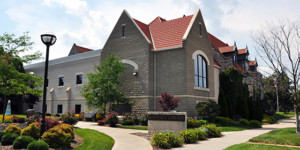 SANDUSKY LIBRARY & THE ERIE COUNTY JAIL – 114 W. Adams St.
SANDUSKY LIBRARY & THE ERIE COUNTY JAIL – 114 W. Adams St.
Libraries and jails may make for strange bedfellows, but not in Sandusky, Ohio. In 1870, a remarkable group of local women undertook a three decade effort to create a library that would serve Sandusky and Erie County. For many years they operated a small subscription library and by 1886 had created a building fund to build or purchase a permanent library. Learn More
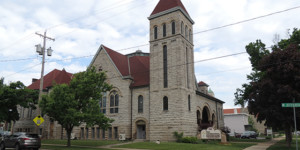 FIRST CONGREGATIONAL CHURCH – 431 Columbus Ave.
FIRST CONGREGATIONAL CHURCH – 431 Columbus Ave.
Walking a block and a half south of Washington Park it is easy to see why this has been called “church corner”. Three major churches are on the corners of Jefferson Street and Columbus Avenue. One of these congregations is First Congregational United Church of Christ. Learn More
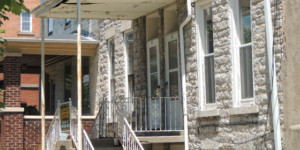 COOKE-ROBERTSON HOUSE – 412 Columbus Ave.
COOKE-ROBERTSON HOUSE – 412 Columbus Ave.
The notoriety of this home’s original owner extended far beyond Sandusky. When William Henry Harrison stopped in Sandusky during his 1840 presidential campaign he was the guest of prominent Whig, Eleutheros Cooke in the adjoining house at 410 Columbus Avenue. Learn More
STOP 8 – Jefferson Crosses – turn left and head east on Jefferson
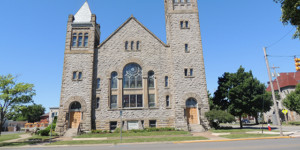
ZION LUTHERAN CHURCH
503 Columbus Ave.
The church building at 503 Columbus Avenue was dedicated on Sunday, November 12, 1899. The architect and builder of Zion Lutheran was George Feick with construction commencing in 1898. The church was built from limestone in the Victorian Romanesque style with beautiful stained glass windows. Learn More
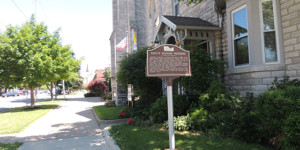
SAINTS PETER & PAUL CATHOLIC CHURCH AND THE KNUTE ROCKNE WEDDING MARKER
510 Columbus Ave.
In 1839, the Reverend Father P.J. Machebeuf began visiting Sandusky to minister to the spiritual needs of the city’s growing Catholic community. He founded Holy Angels church in 1840. Saints Peter and Paul Church was founded in 1865, the second Catholic church in the Sandusky community. Learn More
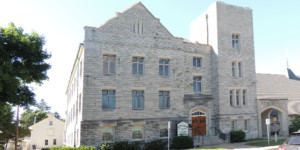
TRINITY UNITED METHODIST CHURCH
214 E. Jefferson St.
In 1918 the Methodist church lost its location at the corner of Washington Street and Jackson Street to make way for the new Post Office. In 1920 the congregation acquired the Charles E. Cooke home. The house was remodeled and used for church purposes while their education building was being constructed behind the home on Jefferson Street – about half way down the block. Learn More
STOP 9 – Wayne St. Crosses – Turn left and head north on the west side of Wayne St.
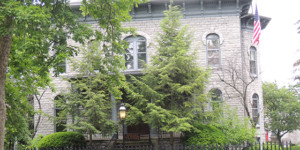
O. MOSS HOUSE
414 Wayne St.
The building at 414 Wayne Street was originally built as the home of Mr. and Mrs. Jay O. Moss in 1872. A portion of the lot was a gift to the couple from Jay’s father, banker A.H. Moss. The remainder of the property was purchased from Oran Follett, who lived nearby at the southeast corner of Wayne and Adams Streets. Learn More
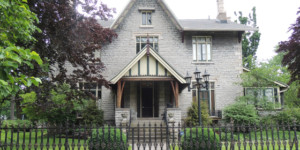
AUGUST H. MOSS HOUSE
428 Wayne St.
August Moss was a prosperous banker and merchant. He lived in this grandiose mansion built for him in 1842, residing near prominent Sanduskians such as Oran Follett, Lester Hubbard, and his brother J. O. Moss. This expansive, elegant home is an example of Gothic Revival Architecture. Learn More
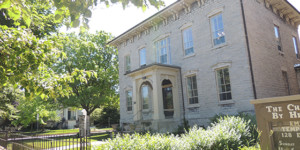
LESTER HUBBARD HOUSE
134 E. Adams St.
Sandusky businessman and banker Lester S. Hubbard built this lovely stone house at the southwest corner of Wayne and Adams Streets in 1852. Helen Hansen wrote in At Home in Early Sandusky that the house was originally on an L-shaped lot and a large barn and barnyard were located at the rear of the lot. Lester S. Hubbard and his wife, the former Jane Patterson Livingston, had a family of ten children. Learn More
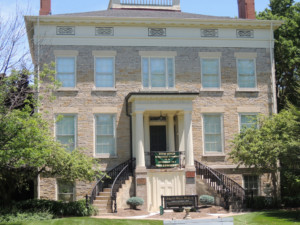
FOLLETT HOUSE MUSEUM
404 Wayne St.
Oran Follett, who was the publisher of the Lincoln-Douglas Debates, resided at 404 Wayne Street. Eliza, Oran’s second wife, was very sympathetic to escaping slaves. According to Eliza’s granddaughter, “No one knows how many slaves she concealed in the basement…or out in the woodshed. She warmed, fed and clothed them, then aided them in their escape across Lake Erie to Canada.” Learn More
STOP 10 – Adam St. crosses
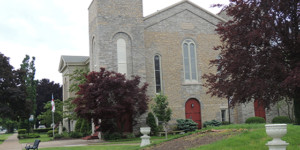
GRACE EPISCOPAL CHURCH
315 Wayne St.
Grace Episcopal Church has the distinction of being the oldest congregation in Ohio whose present church building still incorporates a portion of its original structure. Grace Episcopal Church is the only Ohio Episcopal church organized by lay members without the assistance of clergy. Learn More
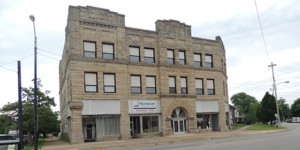
MASONIC TEMPLE
302 Wayne St.
On December 20, 1886 a joint communication from Science Lodge 50 and Perseverance #329 suggested that a Masonic Home be built in Sandusky. The construction started in 1888 and the cornerstone was laid on June 24, 1889. Learn More
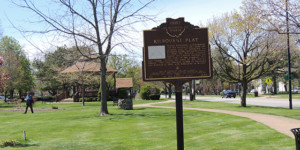
SANDUSKY PLAT MARKER – THE KILBOURNE PLAT
SW corner of Wayne & Washington Sts.
In 1817, James Kilbourne met Isaac Mills and Zalmon Wildman, the owners of the land where Sandusky now stands, and convinced them to pool their resources in order to establish a new city on the south shore of Sandusky Bay. Kilbourne was an entrepreneur, an Episcopal minister, and a surveyor who founded the city of Worthington, including its Masonic Lodge, and many other Ohio towns. Learn More
STOP 11 – Cross East Washington and Head West on the Sidewalk through the Park Staying South of East Washington Row
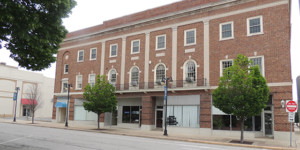
WASHINGTON BUILDING/MAHALA BLOCK
South side of E. Washington Row
In 1894, William West built a four-story commercial structure on East Washington Row between Columbus Avenue and Wayne Street called the Mahala Building. “Mahala” was the middle name of his wife, nee Lydia Mahala Todd.
Learn More
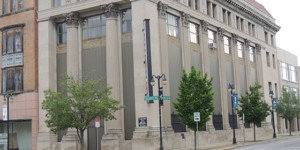
KINGSBURY BUILDING & COMMERCIAL BANKING & TRUST
NE corner of Columbus Ave. & W. Washington Row
William T. West and Abel Kingsbury West were brothers and business partners who built the West House Hotel. After Abel’s death in 1880, William ran their partnership and in 1882 purchased this corner.
Learn More
And here you are – back to the starting point.
